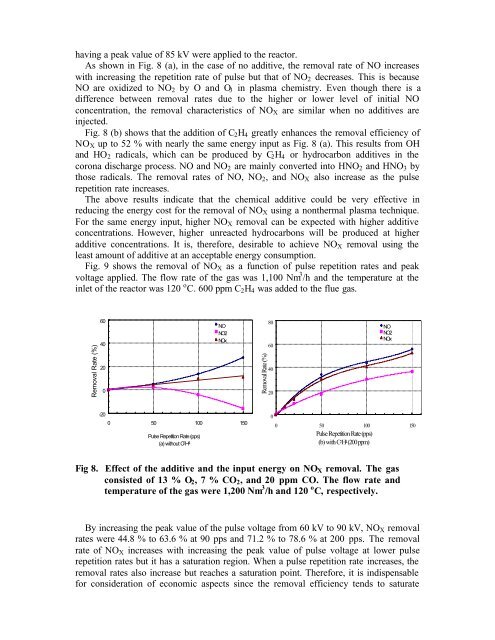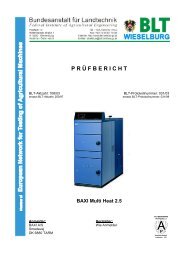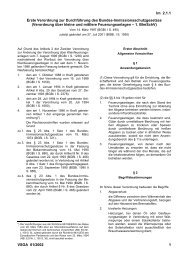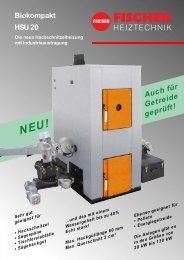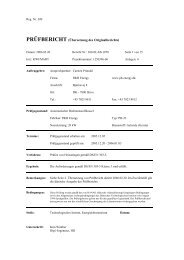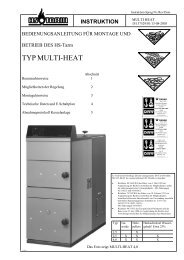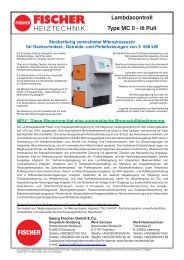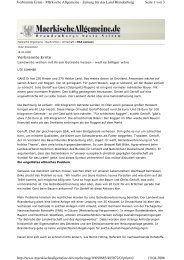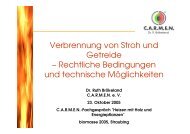Development of 0.5 MWe Scale DeSOX-DeNOX ... - Getreideheizung
Development of 0.5 MWe Scale DeSOX-DeNOX ... - Getreideheizung
Development of 0.5 MWe Scale DeSOX-DeNOX ... - Getreideheizung
Create successful ePaper yourself
Turn your PDF publications into a flip-book with our unique Google optimized e-Paper software.
having a peak value <strong>of</strong> 85 kV were applied to the reactor.<br />
As shown in Fig. 8 (a), in the case <strong>of</strong> no additive, the removal rate <strong>of</strong> NO increases<br />
with increasing the repetition rate <strong>of</strong> pulse but that <strong>of</strong> NO 2 decreases. This is because<br />
NO are oxidized to NO 2 by O and O 3 in plasma chemistry. Even though there is a<br />
difference between removal rates due to the higher or lower level <strong>of</strong> initial NO<br />
concentration, the removal characteristics <strong>of</strong> NO X are similar when no additives are<br />
injected.<br />
Fig. 8 (b) shows that the addition <strong>of</strong> C 2 H 4 greatly enhances the removal efficiency <strong>of</strong><br />
NO X up to 52 % with nearly the same energy input as Fig. 8 (a). This results from OH<br />
and HO 2 radicals, which can be produced by C 2 H 4 or hydrocarbon additives in the<br />
corona discharge process. NO and NO 2 are mainly converted into HNO 2 and HNO 3 by<br />
those radicals. The removal rates <strong>of</strong> NO, NO 2 , and NO X also increase as the pulse<br />
repetition rate increases.<br />
The above results indicate that the chemical additive could be very effective in<br />
reducing the energy cost for the removal <strong>of</strong> NO X using a nonthermal plasma technique.<br />
For the same energy input, higher NO X removal can be expected with higher additive<br />
concentrations. However, higher unreacted hydrocarbons will be produced at higher<br />
additive concentrations. It is, therefore, desirable to achieve NO X removal using the<br />
least amount <strong>of</strong> additive at an acceptable energy consumption.<br />
Fig. 9 shows the removal <strong>of</strong> NO X as a function <strong>of</strong> pulse repetition rates and peak<br />
voltage applied. The flow rate <strong>of</strong> the gas was 1,100 Nm 3 /h and the temperature at the<br />
inlet <strong>of</strong> the reactor was 120 o C. 600 ppm C 2 H 4 was added to the flue gas.<br />
Removal Rate (%)<br />
60<br />
40<br />
20<br />
0<br />
NO<br />
NO2<br />
NOx<br />
Removal Rate (%)<br />
80<br />
60<br />
40<br />
20<br />
NO<br />
NO2<br />
NOx<br />
-20<br />
0 50 100 150<br />
Pulse Repetition Rate (pps)<br />
(a) without C 2 H 4<br />
0<br />
0 50 100 150<br />
Pulse Repetition Rate (pps)<br />
(b) with C 2 H 4 (200 ppm)<br />
Fig 8. Effect <strong>of</strong> the additive and the input energy on NO X removal. The gas<br />
consisted <strong>of</strong> 13 % O 2 , 7 % CO 2 , and 20 ppm CO. The flow rate and<br />
temperature <strong>of</strong> the gas were 1,200 Nm 3 /h and 120 o C, respectively.<br />
By increasing the peak value <strong>of</strong> the pulse voltage from 60 kV to 90 kV, NO X removal<br />
rates were 44.8 % to 63.6 % at 90 pps and 71.2 % to 78.6 % at 200 pps. The removal<br />
rate <strong>of</strong> NO X increases with increasing the peak value <strong>of</strong> pulse voltage at lower pulse<br />
repetition rates but it has a saturation region. When a pulse repetition rate increases, the<br />
removal rates also increase but reaches a saturation point. Therefore, it is indispensable<br />
for consideration <strong>of</strong> economic aspects since the removal efficiency tends to saturate


